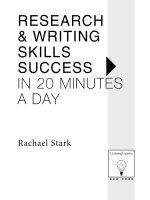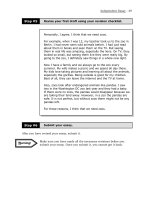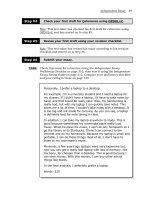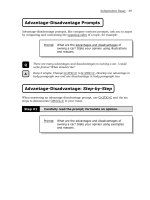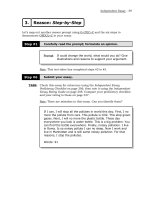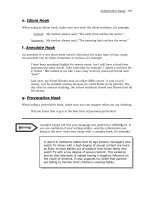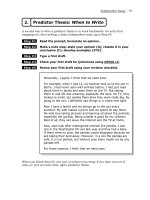Tài liệu RESEARCH AND WRITING SKILLS SUCCESS PART 6 ppt
Bạn đang xem bản rút gọn của tài liệu. Xem và tải ngay bản đầy đủ của tài liệu tại đây (73.06 KB, 7 trang )
B
efore you walk into your favorite library, sit down and make a list of five possible places
where you might find as much information about your topic as you can. For example, if
you are researching the assassination of President John F. Kennedy, five possible places to visit
might be:
1.
A neighborhood public library or city public library
2.
A local university or college
3.
A historical library or specific historical collection
LESSON
Getting Essential
Information
from Print
Sources
LESSON SUMMARY
Now you have your writing tools and equipment ready. You also
have a library card or access to an academic or cultural institution.
In addition, you have narrowed down your topic to make it as spe-
cific as possible. You are ready to begin your search for informa-
tion and materials. This is the most fun and exciting part of the
process! Rather than just thinking about your paper, you are now
an active participant in the research process. You will become a
detective, piece together and track down various types of infor-
mation, follow your leads, and question as many individuals as you
can. This lesson will focus on different institutions that you can uti-
lize, the diverse printed resources available, and how to make the
most of them.
3
23
4.
A cultural institution devoted to
American history topics
5.
A museum or gallery with an American
history collection
This list allows you to obtain information
from more than one source and ensures that
the information you gather will be diverse and
in a variety of different forms. Some institu-
tions may be more helpful than others and
offer you more materials, but having many
options is valuable.
Navigating a Library
Libraries are often crowded and librarians may
seem to be too busy to help you in your per-
sonal search. While it is true that librarians
may seem busy, they are usually more than
delighted to assist you in any way they can.
Remember, they are the experts about treasured
library collections and materials! Even though
you can roam the shelves for yourself, librari-
ans have access to and know about books and
other materials that may be behind the desk. It
always pays to ask a librarian for help before
you begin to search on your own. As you
learned to do in the previous chapter, explain
your topic as specifically as you can to the
librarian. Make sure that you provide the
librarian with the topic (the who or what of
your paper), the years you are researching (the
when of your paper), the geographic location
(the where of your paper), and what you are
proving with your writing (the why of your
paper). This will allow the librarian to guide
you to the most useful and valuable sources.
Understanding Printed
Sources
Printed material generally includes books,
newspapers, magazines, pamphlets, or excerpts
of essays—in other words, any written materi-
al on your topic. These printed materials are
usually grouped into two categories:
primary sources
secondary sources
Primary Sources
The first category is printed primary source
material. All primary source materials are first-
hand accounts of circumstances by individuals
who are directly involved or have experienced
what they are writing about firsthand. Unique
primary sources—often overlooked—include
personal diaries from a particular time period,
physical, geographical, or topographical maps,
official documents (such as a census or other
collections of statistics), paintings, prints, and
photographs of particular areas you are
researching. Although you may not typically
think of consulting such diverse sources,
Lesson 5 explains why these sources are often
the most valuable for your work.
Secondary Sources
The other category of printed materials is
known as secondary sources. These include
books, magazine articles, or pamphlets by
authors who have already collected materials
and written about events after they have
occurred, or from a perspective that is not imme-
diate or firsthand. Common secondary sources
that are extremely helpful to consult include:
–
GETTING ESSENTIAL INFORMATION FROM PRINT SOURCES
–
24
Source What You’ll Find In It Examples/Where You’ll Find It
almanacs and statistics, facts, trivia by year (Hint: The World Almanac, Facts on File
yearbooks you’ll need to look at the 2000 volume
for information on 1999)
atlases maps, information about geography, National Geographic Atlas,
including climate, rainfall, crops, Rand McNally Atlas of the World
population, topography, political
systems
biographical information about famous people— Larousse Dictionary of Scientists, Webster’s
dictionaries significant actions and contributions Biographical Dictionary of American Authors,
they made to history often arranged African-American Women: A Biographical
chronologically or by historical and Dictionary, Who’s Who
political significance
dictionaries lists of words, their meanings, usage, The Oxford English Dictionary (O.E.D.)—in
history, and pronunciation print form or also available on CD-ROM—
for the most complete word etymology and
derivations in the English language,
Webster’s New Collegiate Dictionary,
Academic Press Dictionary of Science and
Technology, Harvard Dictionary of Music
encyclopedias articles on different topics as well as Encyclopaedia Britannica, The World Book
short summaries and synopses of Encyclopedia, Encyclopedia of Mammals,
ideas, individuals, and their ultimate Larousse Dictionary of World Folklore, The
contributions to society and history Book of Knowledge, Columbia Encyclopedia
databases electronic compilations of articles FirstSearch, EBSCOhost, AskJeeves.com,
from periodicals and other sources Quest, Yahoo.com
indexes lists of articles that have been Reader’s Guide to Periodical Literature
published in periodicals
–
GETTING ESSENTIAL INFORMATION FROM PRINT SOURCES
–
25
■
reference books, such as comprehensive or
particular subject encyclopedias
■
compendiums of various kinds, such as
biographical histories of individuals
■
a collected history of ideas or world
philosophies
■
a Reader’s Guide to current and past peri-
odicals and printed articles
■
dictionaries
■
other compiled indexes according to sub-
ject matter, thesauruses and atlases.
Often, the range and scope of reference
materials that most libraries or institutions
have on hand is extremely broad and fascinat-
ing. With these tools, it is possible to research
just about any topic in existence if you know
where to look. Below is a helpful chart that
illustrates some of the printed materials avail-
able to you at almost all libraries. This chart
provides a handy jumping off point to begin
collecting your data.
Source What You’ll Find In It Examples/Where You’ll Find It
Internet access to websites around the world
periodicals magazines and newspapers—articles The New York Times, The Wall Street Journal,
may be found in hard copy, on micro- The New Yorker, The Science Teacher,
film or microfiche, or in electronic Consumer Reports
databases
quotation books lists of quotations arranged by author, Oxford Dictionary of Quotations,
source, keyword, subject, and so on— Bartlett’s Familiar Quotations, A History
also provides the specific work and of Shakespearean Quotations
context from which the quote emerged
vertical file booklets, catalogs, pamphlets, and other See your librarian for assistance.
materials filed by subject—can also
include Ph.D. dissertations that have
been published and circulated on your
topic at various academic institutions
photograph and black and white or color photographs public libraries and historical societies
picture archives listed by year and subject matter as
well as any drawings, paintings, or
sketches
musical, dance, records, tape recordings, CDs, and most Fine Arts libraries or Fine Arts
or instrumental videotapes institutions, national dance centers, or
index and listings performing arts institutions
Rare Book and original, fragile, and dated documents public libraries, historical and cultural
Manuscript preserved from their time period institutions
Room
–
GETTING ESSENTIAL INFORMATION FROM PRINT SOURCES
–
26
Odds are that you will find more than
enough materials for your needs as you use
this chart for a guide. The nice thing about vis-
iting libraries or unique institutions is that you
get to see many rare, old, and invaluable mate-
rials that have not been scanned into the
Internet or are not available on the Web. Even
if these materials are difficult to locate or you
cannot borrow them, it is important to see
them so that you are as informed as possible
about your topic. By visiting many libraries,
you will often discover sources that others
have overlooked.
Summary
Many different types of institutions will have
information available to you. Make sure that
you utilize and visit as many of these places as
possible because the more places you visit, the
more rich and diverse your information will
be. Always remember to consult a librarian or
other professional to assist you in your per-
sonal search.
